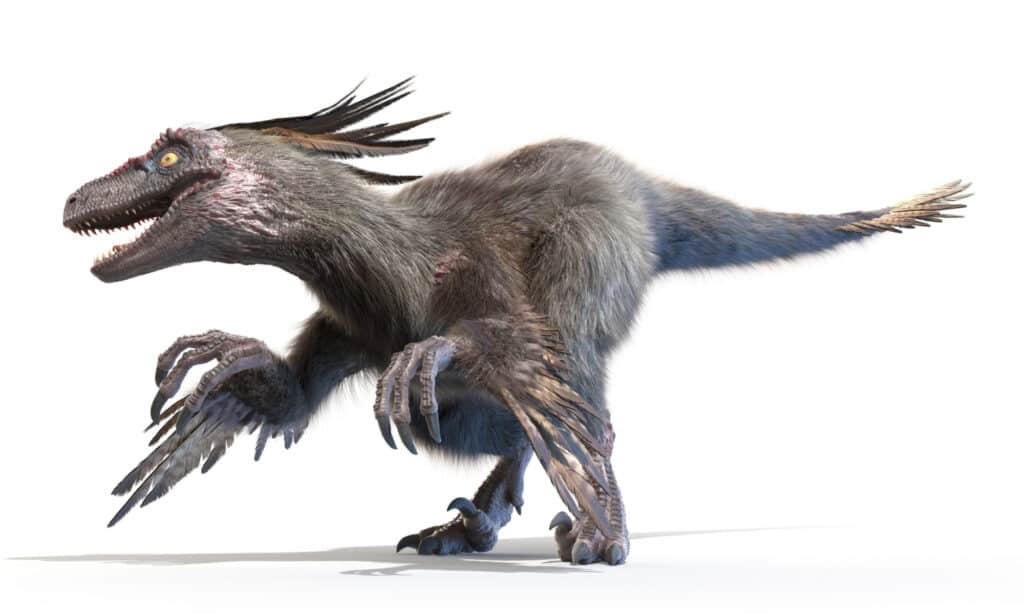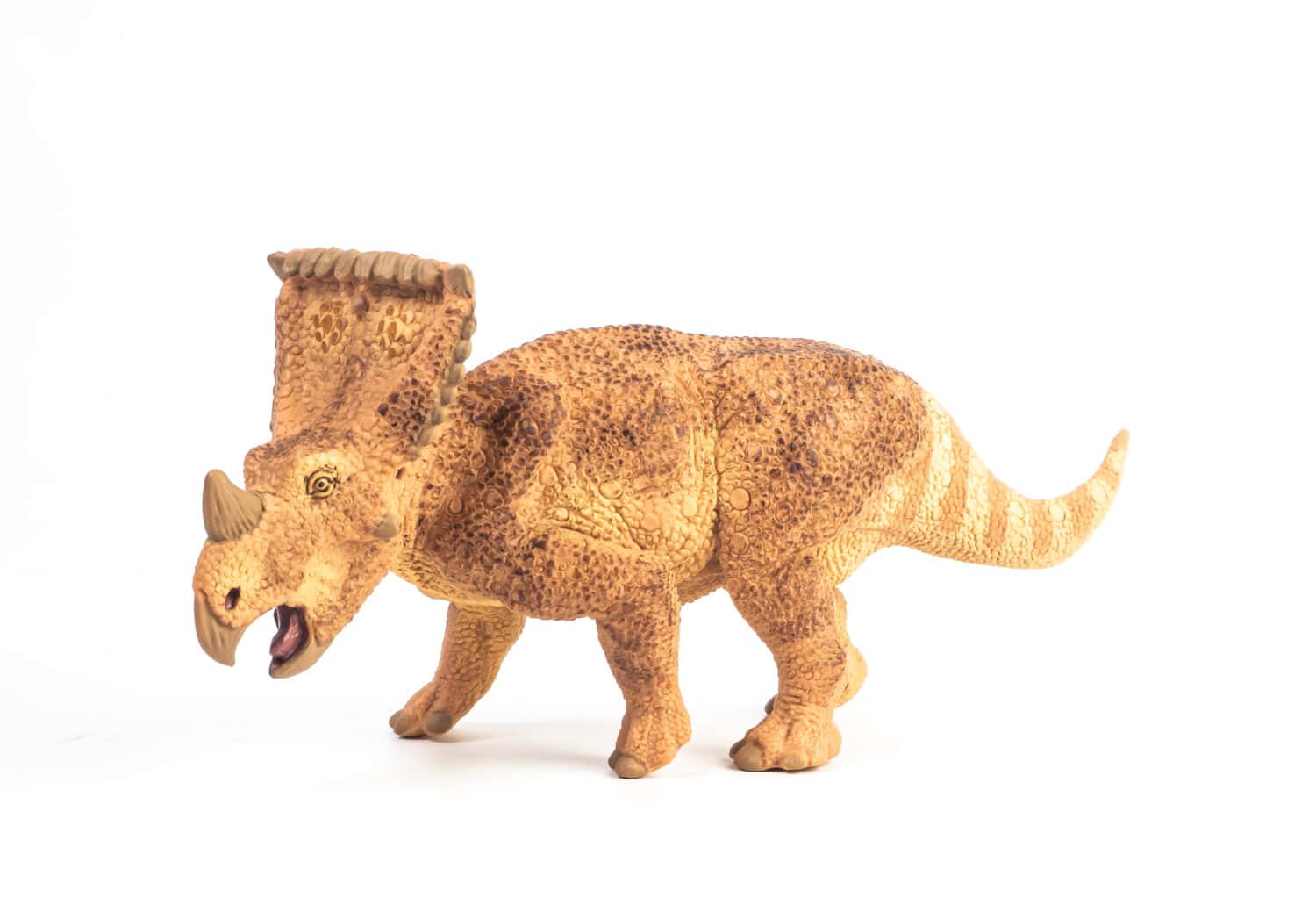We all know about the Tyrannosaurus, Stegosaurus, and Triceratops, but what about dinosaurs that start with V? Currently, there are more than 700 known species of dinosaurs, each with their own scientific name. Despite the large number, only a handful of dinos names start with the letter V.
We must first examine how dinosaurs are named to understand why this is. They are either named after a body feature, the location where they are found, or the person who found the remains. All names are Greek or Latin and have a genus and species name. Considering most names don’t start with a “v,” this is why.
Now that we understand that, let’s look at the dinosaurs that start with a V.
#1: Velociraptor

Velociraptors were believed to be scaled until 2007 when a discovery confirmed they were feathered!
©SciePro/Shutterstock.com
By far, the most well-known dinosaur with the letter v is the Velociraptor. The velociraptor fossil was first discovered on August 11, 1923, in the Flaming Cliffs in the Gobi Dessert by Peter Kaisen. Its given Latin name translates into “quick plunderer” and is a node to their effective hunting abilities.
The Velociraptor is a part of the Dromaeosauridae family and lived early 89.8 to 72.1 million years ago in the Cretaceous to Maastrichtian period. This tiny yet deadly hunter existed in what is known as modern-day Mongolia.
Regarding looks, the Velociraptor was a feathered carnivore instead of scaled like shown in media. The dinosaur’s body features a long tail and a large sickle-shaped claw on its hindfoot. It could be distinguished from other dromaeosaurids due to two features, which are the low skull and upturned snout. Size-wise, the Velociraptor was only 31 to 43 lbs and stood less than two feet tall.
#2: Valdosaurus

A Valdosaurus was very similar in look to a lizard, except it had distinctive features of bipedal herbivores.
©YuRi Photolife/Shutterstock.com
The Valdosaurus is a herbivore dinosaur first discovered in 1848 by Gideon Mantell. Two thighbones were discovered near Cowleaze Chine, a geological feature on the southwest coast of the Isle of Wight, England. Since its discovery, the Valdosaurus underwent many name changes but eventually landed on Valdosaurus.
The Valdosaurus is a bipedal herbivorous iguanodont ornithopod dinosaur and lived in England, Spain, and Romainia. It walked the earth during the early Cretaceous period, which was nearly 145 to 125 million years ago. Known as the “weald lizard,” it was a friendly dinosaur that walked on two legs and ate plants.
A Valdosaurus can be described as kangaroo-shaped, four feet long, weighing up to 25 pounds. Distinctive features include three-toed feet and a horny beak. Other key features include sturdy hind limbs, wide hands, and an elongated snout.
#3: Velafrons

Velafrons one distinctive feature is the bony crest on its forehead.
©MR1805/iStock via Getty Images
The Velafrons took nearly a decade to dig out of the ground, which took place between 1992 to 2001. The Dinamation International Society discovered it and was located in the Cerro del Pueblo Formation in Mexico. While excavators did their best, only part of it was discovered. Mainly the skull, a partial skeleton with a bony crest.
The Latin meaning of Velafrons translates into “sailed forehead,” a distinctive feature on this dinosaur’s head. It was part of the genus of lambeosaurine hadrosaurid and was alive nearly 72 million years ago.
A Velafrons was a duck-billed dinosaur with a distinctive beak for clipping vegetation. Inside the beak were tightly packed teeth, which would be used for chewing. Despite having two strong hind legs, the Velafrons could have walked on all fours or its hind legs.
A distinctive feature of the Velafrons was its bony crest forehead, similar to a boat sail. Ultimately, it was low to the ground and had a broad skull. Adult Velafrons stand up to 35 feet and weigh 4,400 lbs.
#4: Veterupristisaurus
The Veterupristisaurus was first found due to a holotype specimen of MB R 1938, which is a caudal vertebra. This species is from Jurassic Tanzania and is one of the earliest carcharodontosaurids to exist. By far, it was one of the most deadly predators to exist during the Jurassic period.
Veterupristisaurus loosely translates to “old shark lizard” due to its sharp teeth. The species was one of the first shark-toothed lizards in the carcharodontosaurids family.
The Veterupristisaurus was a very large dinosaur that towered over others. It was nearly 33 feet long and could weigh up to two tons. Visually, you could describe its look similar to that of a T-Rex. However, the main difference was its shark-like teeth and narrow jaw.
#5: Vulcanodon
The Vulcanodon was first discovered in 1969 in Zimbabwe and is one of the most primitive sauropods discovered. It’s a ground-dwelling herbivore with thick column-like legs and a long neck and tail. The dinosaur is a single locality on Lake Ariba and nowhere else.
Vulcanodon is a name that translates to “volcano tooth” and was named by Michael Raath in 1972. The name refers to the skeletal remains that were found between two lava flows with knife-shaped teeth. The teeth were confirmed to have been to a theropod, not the Vulcanodon.
A Vulcanodon was a small sauropod measuring 36 feet in length. It features a long neck and tail, similar to a giraffe. Distinctive features include its unusually long forelimbs and short toes. As an estimate, scientists expect that the VUlcanodon weighed up to 3.5 tons.
#6: Vayuraptor
The Vayuraptor’s discovery was in 1988 by Paladej Srisuk at the Phy Wat Site A1 in Nong Bua Lamphy Province, Thailand. The Vayuraptor only has one genus with a partial skeleton. It’s a carnivore and a mid-sized theropod.
The species lived around 130 to 65 million years ago during the Cretaceous period. Its name, Vayuraptor, translates to “wind thief,” as it was named after the Hindu god Vayu. The name was because physical attributes such as a long gracile tibia suggested it was fast and agile.
A Vayuraptor was a mid-sized dinosaur that was 15 feet long. Distinctive features include its long snout, big claws, and long slender legs. The distinctive features could have made it a potential member of the Megaraptora clade of dinosaurs.
#7: Vagaceratops

The Vagaceratops is very similar to the Triceratops but includes a different frill shape with horns.
©kamomeen/Shutterstock.com
The Vagaceratops’s discovery was in 2001 in the Dinosaur Provincial Park Formation in Alberta, Canada. At first, scientists believed it to be a new species of Chasmosaurus. Still, since 2010, it has been in the genus Chasmosaurus as the Chasmosaurus irvinesis. It’s a medium-sized ceratopsian with a holotype skull.
Vagaceratops means “wandering horned face” in Latin and refers to its relationship with the Kosmoceratops. It was alive during the Late Cretaceous period and lived in Alberta nearly 100.5 to 66 million years ago.
A Vagaceratops spanned 16 feet long and weighed an estimated 1.3 tons. Distinctive features of the dinosaur include a row of small horns around its frill. Each of them is centrally flattened, curved forward and upward. Other distinctive features include a short nose horn and a brown horn.
#8: Vahiny
The Vahiny was named by Kristina Curry Rogers and Jeffery A. Wilson in 2014. It was first found in the Late Cretaceous Maevarano Formation in northwestern Madagascar. The species braincase was first discovered in 2005 and later followed by many skeleton pieces and skulls.
Vahiny is a Malagasy word for “traveler” and originated from Madagascar. This was mainly due to being a single species in Madagascar that wasn’t similar to any others. The dinosaur was alive during the Late Cretaceous period.
The Vahiny was estimated to be 44.9 feet in length and weigh a total of 11,905 lbs. It’s distinguishable from other titanosaurs due to its braincase. Look-wise, the dinosaur is similar to the Apatosaurus but has distinctive brown and white coloring.
#9: Venaticosuchus
The Venaticosuchus was first discovered in the early 1960s from Cerro Las Lajas in La Rioja, Argentina. Its genus was based on an incomplete skull and jaw found in the Late Triassic Ischigualasto Formation in the Ischigualasto-Villa Union Basin. Scientists had to reconstruct the jaw musculature to help get an image of what the dinosaur looked like.
Venaticosuchus doesn’t have a meaning, unlike other dinosaurs. Instead, it is a genus of crocodile that was alive during the Middle Triassic in Argentina. The Middle Triassic period lasted from 247.2 to 237 million years ago and was the second epoch in the Triassic period.
A Venaticosuchus is a medium-sized predator that spans seven feet in length. There were distinctive features that scientists could find, but the skeletal remains are incomplete to this day. Its known features are smooth and thin surangular and articular bones with a robust dentary. In addition, it had sharp, gnarly teeth that helped break apart bones and rip flesh.
The face of a Venaticosuchus was very blocky, and they had a large head with a narrow face. The weight of the species is unknown, as no one discovered all the bones. Most of what is known today is through computer guesses.
#10: Vectiraptor
The Vectiraptor was discovered by Mick Green in 2004 inside rocks in the Wessex Formation. The Wessex Formation is located on Compton Bay on the Isle of Wight in the United Kingdom. It is the only species and type of Vectriraptor greeni.
Vectriaptor means “Isle of Wight thief” and the greeni species name is a nod to Mike Green, who discovered it. This dinosaur lived during the Early Cretaceous period, which was 130 to 125 million years ago.
A Vectiraptor’s body size can span 8.2 to 9.8 feet. Along with its massive size, the dinosaur could weigh anywhere between 185 to 200 lbs. When it was alive, it was the largest dromaeosaur in Europe.
Similar to the Velociraptor, it is also a feathered predator. It includes short vertebrates with tall neural spines. There are also long-stalked ribs that help it quickly chase after prey. These smaller dinosaurs were known to hunt in packs, which would help them bring down larger dinosaurs.
List of Other Dinosaurs That Start with V
The above is not a comprehensive list of all the dinosaurs that start with the letter v. Instead, there are a handful more dinosaurs that we couldn’t mention. Below is a list of dinosaurs that we didn’t cover that start with a v:
- Valdoraptor
- Valibonavenatrix
- Variraptor
- Vectaerovenator
- Vectensia
- Vectidromeus
- Vectipelta
- Vectisaurus
- Velocipes
- Velocisaurus
- Venaticosuchus
- Venenosaurus
- Vespersaurus
- Viavenator
- Vitakridrinda
- Vitakrisaurus
- Volgatitan
- Volkheimeria
- Vouivria
Summary of Dinosaurs That Start with V
| Number | Dinosaur |
|---|---|
| 1 | Velociraptor |
| 2 | Valdosaurus |
| 3 | Velafrons |
| 4 | Veterupristisaurus |
| 5 | Vulcanodon |
| 6 | Vayuraptor |
| 7 | Vagaceratops |
| 8 | Vahiny |
| 9 | Venaticosuchus |
| 10 | Vectriaptor |
The photo featured at the top of this post is © Anton_Ivanov/Shutterstock.com
Thank you for reading! Have some feedback for us? Contact the AZ Animals editorial team.







